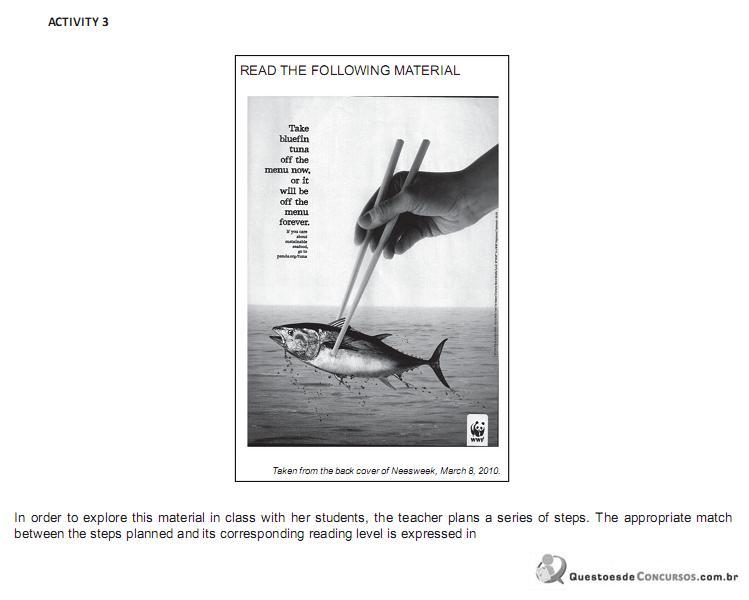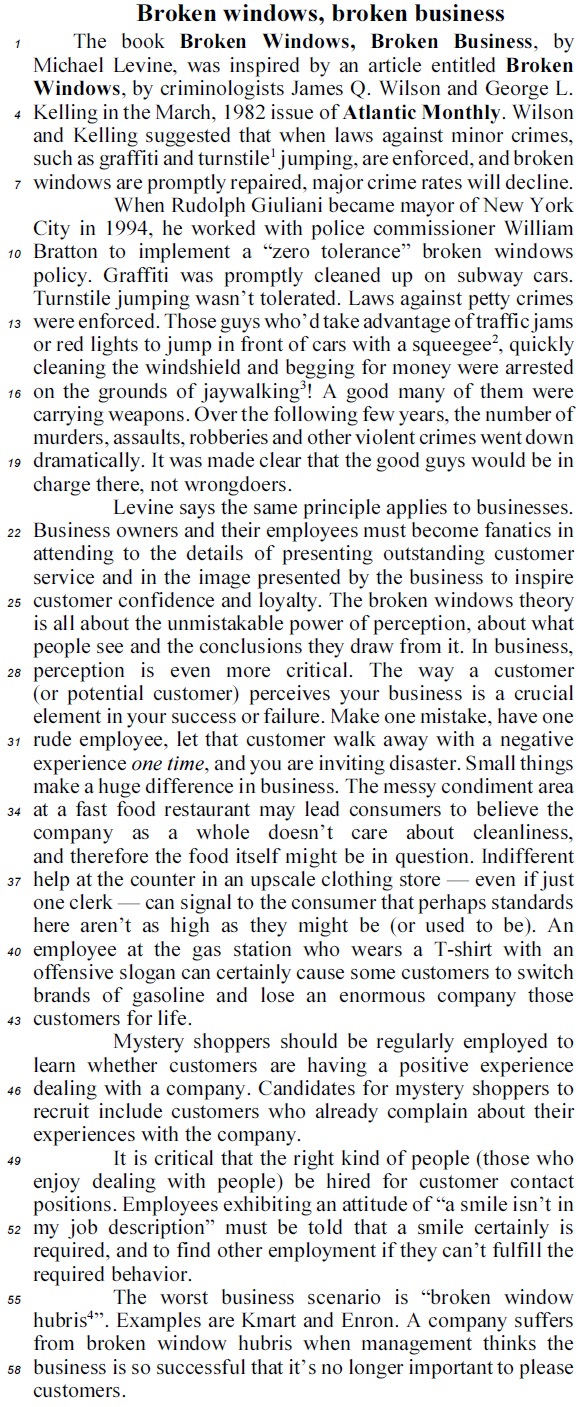Questões de Concurso
Comentadas sobre aspectos linguísticos | linguistic aspects em inglês
Foram encontradas 616 questões
items.
Considering translation and some of the notions it envolves, judge
the following items.
Formal correspondence is a concept which refers to the equivalence between the original text and the translated test in terms of register.
Considering translation and some of the notions it envolves, judge
the following items.
Concerning translation, faithfulness and adequacy can be used interchangeably as they both refer to the same translation strategy.
Considering translation and some of the notions it envolves, judge
the following items.
Context can be defined as extra-textual features which determine the translation of a linguistic expression or a whole text.
Considering translation and some of the notions it envolves, judge
the following items.
Equivalence is a much debated term in translation studies for want of a widely accepted definition.
Considering translation and some of the notions it envolves, judge
the following items.
Acceptations which go beyond the primary meaning of a linguistic expression can be said to be connotative.
Some of you may be familiar with OSHA - the Occupational Safety & Health Administration. The sole purpose of this agency is to keep American workers safe. Complying with OSHA regulations isn't always easy, but if we work together, we can do it. Yet, complying with regulations is not the real reason for working safely. Our real motive is simple. We care about each and every one of you and will do what is necessary to prevent you from being injured.
However, keeping our workplace safe takes input from everyone. Management, supervisor, and all of you have to come together on this issue, or we're in trouble. For example, upper management has to approve the purchase of safe equipment. Supervisors, including myself, have to ensure that each of you knows how to use that equipment safely. Then it's up to you to follow through the task and use the equipment as you were trained. If any one part of this chain fails, accidents are going to happen and people are going to get hurt.
Responsibility Number One - Recognize Hazards
At the core of your safety responsibilities lies the task of recognizing safety and health hazards. In order to do that, you must first understand what constitutes a hazard. Extreme hazards are often obvious. Our hopes are that you won't find too many of those around here.
There are, however, more subtle hazards that won't jump up and bite you. As a result of your safety training and meetings like these, some things may come to mind. For example, a machine may not be easy to lock out. Common practice may be to use a tag. This is a potential hazard and should be discussed. Maybe something can be changed to make it easier to use a lock. Other subtle hazards include such things as frayed electrical cords, a loose machine guard, a cluttered aisle, or maybe something that just doesn't look right.
Responsibility Number Two - Report Hazards
A big part of recognizing hazards is using your instincts. Nobody knows your job as well as you do, so we're counting on you to let us know about possible problems. Beyond recognizing hazards, you have to correct them or report them to someone who can. This too, is a judgement call. For example, if something spills in your work area you can probably clean it up yourself. However, if there is an unlabeled chemical container and you have no idea what it is, you should report it to your supervisor.
Additional Employee Responsibilities
Good housekeeping is a major part of keeping your work area safe. For example, you should take a few minutes each day to ensure that aisles, hallways, and stairways in your work area are not obstructed. If boxes, equipment, or anything else is left to pile up, you have a tripping hazard on your hands. Those obstructions could keep you from exiting the building quickly and safely should you face an emergency situation.
Also watch out for spills. These can lead to slips and falls. Flammable materials are another thing to be aware of. Make sure they are disposed of properly.
Keep Thinking. Even if you're doing your job safely and you are avoiding hazards, there are often even better ways to work safely. If you have ideas for improving the safety of your job or that of co-workers, share them.
Concluding Remarks
While nothing we do can completely eliminate the threat of an incident, we can work together to improve our odds. As I said, this must be a real team effort and I'm counting on input from all of you. Let's keep communicating and continue to improve safety.
Available at: <http://www.ncsu.edu/ehs/www99/right/training/meeting/emplores.html>.Retrieved on: April 1st, 2012. Adapted.
In “than the reading of whole volumes” (L.9-10), the omission of the definite article would not interfere with the grammar correction of the sentence.

All of the following language features are found in the fragment and could be highlighted by the teacher to help students grasp the form and meaning of this passage, but for
Written by Laura Hill
Water and oil don’t mix. We see this every day; just try washing olive oil off your hands without soap or washing your face in the morning with only water. It just doesn’t work!
When an oil spill occurs in the ocean, like the catastrophe in the Gulf of Mexico, what do scientists do to clean up the toxic mess? There are a number of options for an oil spill cleanup and most efforts use a combination of many techniques. The fact that oil and water don’t mix is a blessing and a curse. If oil mixed with water, it would be difficult to divide the two.
Crude oil is less dense than water; it spreads out to make a very thin layer (about one millimetre thick) that floats on top of the water. This is good because we can tell what is water and what is oil. It is also bad, because it means the oil can spread really quickly and cover a very large area, which becomes difficult to manage. Combined with wind, ocean currents and waves, oil spill cleanup starts to get really tricky.
Chemical dispersants can be used to break up big oil slicks into small oil droplets. They work like soaps by emulsifying the hydrophobic (waterrepelling) oil in the water. These small droplets can degrade in the ecosystem quicker than the big oil slick. But unfortunately, this means that marine life of all sizes ingest these toxic, broken-down particles and chemicals.
If the oil is thick enough, it could be set fire, a process called “in situ burning”. Because the oil is highly flammable and floats on top of the water, it is very easy to set it alight. It’s not environmentallyfriendly though; the combustion of oil releases thick smoke that contains greenhouse gases and other dangerous air pollutants.
Some techniques can contain and recapture spilled oil without changing its chemical composition. Booms float on top of the water and act as barriers to the movement of oil. Once the oil is controlled, it can be gathered using sorbents. “Sorbent” is a fancy word for sponge. These sponges absorb the oil and allow it to be collected by siphoning it off the water.
However, weather and sea conditions can prevent and obstruct the use of booms, sorbents and in situ burning. Imagine trying to perform these operations on the open sea with wind, waves and water currents moving the oil (and your boat!) around on the water.
What about the plants and animals? It’s easy to forget about the organisms in the sea that are under water. Out of sight, out of mind! There is not much we can do to help them. But when oil reaches the shore it impacts sensitive coastal environments including the many fish, bird, amphibian, reptilian, and crustaceanspecies that live there. We have easy access to these areas and there are some things we can do to clean up. For the plants, it is often a matter of setting them on fire, or leaving them to degrade the oil naturally. Sometimes, we can spray the oil with nutrients (phosphorus and nitrogen) that can encourage the growth of specialized microorganisms. For species that can tolerate our soaps, manpower is needed to wash every affected animal. Yet, if the animal has tried to lick itself clean, it can die from ingesting the toxic oil.
Unfortunately, there can be many negative economic and social impacts, in addition to the environmental impacts of oil spills and, as you’ve just read, the clean up techniques are far from perfect. Prevention is the very best cleanup technique we have. http://www.curiocity.ca/everyday-science/environme... -cleaning-up-a-spill.html, retrieved on Dec 10, 2010

Internet: www.profitadvisors.com (adapted).
1turnstile – a narrow gate at the entrance of something, with metal bars that move in a circle so that only one person at a time can go through.
2squeegee – an object used for cleaning windows, consisting of a short handle with a rubber blade.
3jaywalking – a dangerous or illegal way of crossing a street at a place where cars do not usually stop.
4hubris – a very proud way of talking or behaving that offends people.
In the text,
Let's talk about User Account Control ? the Windows
Vista security element that was a prominent example for
everything that bothered people about that OS. UAC aimed to
prevent rogue software from tampering with your PC by
endlessly prompting you to approve running applications or
changing settings. The experience was so grating that many
users preferred to turn UAC [PARTICLE] and [VERB] their
chances with Internet attackers. Those who left it active risked
slipping into the habit of incautiously clicking through every
prompt, defeating whatever value the feature might have had.
Whereas Vista's notorious User Account Control gave
users no control over the feature other than to turn it off,
Windows 7's version of UAC lets users choose from two
intermediate notification levels between 'Always notify' and
'Never notify'.
Windows 7 gives you control over UAC, in the form of a
slider containing four security settings. As before, you can
accept the full-blown UAC or elect to disable it. But you can also
tell UAC to notify you only when software changes Windows
settings, not when you're tweaking them yourself. And you can
instruct it not to perform the abrupt screen-dimming effect that
Vista's version uses to grab your attention.
If Microsoft had its druthers, all Windows 7 users [TO
USE] UAC in full-tilt mode: The slider that you use to ratchet
back its severity advises you not to do so if you routinely install
new software or visit unfamiliar sites, and it warns that disabling
the dimming effect is "Not recommended."
 , Redmond: I
, Redmond: Ihave every intention of recommending the intermediate settings
to most people who ask me for advice, since those settings
retain most of UAC's theoretical value without driving users
bonkers.
(Adapted from
http://www.pcworld.com/article/172602/windows_7_review.html)
on many factors - how the energy is being used, where
it is being used, what energy sources are available,
which sources are most convenient and reliable, which
5 are easiest to use, what each costs, and the effects on
public safety, health, and the environment. Making smart
energy choices means understanding resources and their
relative costs and benefits.
Some energy sources have advantages for specific
10 uses or locations. For example, fuels from petroleum
are well suited for transportation because they pack a
lot of energy in a small space and are easily transported
and stored. Small hydroelectric installations are a good
solution for supplying power or mechanical energy close
15 to where it is used. Coal is widely used for power
generation in many fast-developing countries - including
China, India, and many others - because domestic
supplies are readily available.
Efficiency is an important factor in energy costs.
20 How efficiently can the energy be produced, delivered,
and used? How much energy value is lost in that process,
and how much ends up being transformed into useful
work? Industries that produce or use energy continually
look for ways to improve efficiency, since this is a key to
25 making their products more competitive.
The ideal energy source - cheap, plentiful, and
pollution-free - may prove unattainable in our lifetime,
but that is the ultimate goal. The energy industry is
continuing to improve its technologies and practices, to
30 produce and use energy more efficiently and cleanly.
Energy resources are often categorized as
renewable or nonrenewable.
Renewable energy resources are those that can be
replenished quickly - examples are solar power,
35 biomass, geothermal, hydroelectric, wind power, and
fast-reaction nuclear power. They supply about seven
percent of energy needs in the United States; the other
93 percent comes from nonrenewables. The two largest
categories of renewable energy now in use in the U.S.
40 are biomass - primarily wood wastes that are used by
the forest products industry to generate electricity and
heat - and hydroelectricity.
Nonrenewable energy resources include coal, oil,
natural gas, and uranium-235, which is used to fuel
45 slow-reaction nuclear power. Projections of how long a
nonrenewable energy resource will last depend on many
changeable factors. These include the growth rate of
consumption, and estimates of how much of the remaining
resources can be economically recovered. New exploration
50 and production technologies often increase the ability of
producers to locate and recover resources. World
reserves of fossil energy are projected to last for many
more decades - and, in the case of coal, for centuries.
In: http://www.classroom-energy.org/teachers/energy_tour/pg5.html





